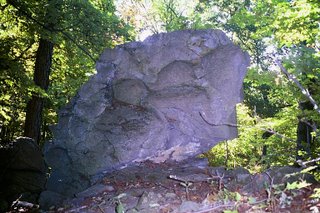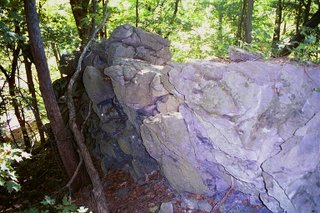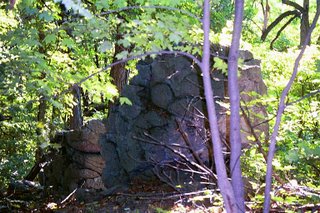
By Geophile
Let me write a little preface to another part of this story. I used to interview naturalists (no, not naturists which is another thing entirely and would no doubt make for a more visually interesting blog) for a publication I edited for a short time. After doing a number of these interviews, I noticed something--when they had given me the information I needed, we would talk amiably and then there would be a comment like "Don't tell anybody what I'm going to tell you," or "Don't print this," and then they would launch into a story of an event they experienced in nature which they regarded as extraordinary, spiritual or supernatural in some way. This happened often enough so that I began to think of it as a phenomenon in itself, maybe a mental effect generated by spending so much time out in the natural world which was the environment that shaped our minds in the first place, maybe a reflexive effect that created the illusion that something was 'out there.'
Now, as rock heads we necessarily spend a lot of time out in nature, too. So it's not too surprising that some of us have stories that seem a little flaky, stories that we hesitate to tell because they make us look unscientific. However, hiding true stories because they don't jibe with the world view we want to adhere to is a way of never getting to the whole picture. I say all this to appease those who are uncomfortable with this sort of material. Among some of the descendants of native people I've known all this explication would just be the source of a good laugh.
So here's another curious incident. First another picture of the rock ridge on the hill near the Lehigh. Sorry about the glare . . .

Same ridge from the other side, looking down the hill.
 When I was there the first time, I found a tiny iridescent red feather on a flat stone there. An odd thing to notice, something so tiny. It could only have been a throat feather from a ruby-throated hummingbird.
When I was there the first time, I found a tiny iridescent red feather on a flat stone there. An odd thing to notice, something so tiny. It could only have been a throat feather from a ruby-throated hummingbird.Here's the rock ridge front-on, with the head facing us.
 After this second time I went, when I took pictures, got stung and banned from the property, and then was told off, I was home doing the dishes when I saw what looked like a maple leaf on the lawn after a rain. As I did the dishes, I became less and less sure it was a leaf. When I went out to check, I found a hummingbird, a juvenile male, spread out on the grass but alive. I had a feeder, so I brought him in to keep him safe for the night and give him a chance to revive. I put a screen over the box we kept him in. Here he is. Pictures of him make up the rest of the roll I took at that site.
After this second time I went, when I took pictures, got stung and banned from the property, and then was told off, I was home doing the dishes when I saw what looked like a maple leaf on the lawn after a rain. As I did the dishes, I became less and less sure it was a leaf. When I went out to check, I found a hummingbird, a juvenile male, spread out on the grass but alive. I had a feeder, so I brought him in to keep him safe for the night and give him a chance to revive. I put a screen over the box we kept him in. Here he is. Pictures of him make up the rest of the roll I took at that site.
In the morning, I put him out on the feeder in the open box. When I came home from work he was gone.
I won't try to interpret it into something understandable. Peter says hummingbirds have significance in Indian lore, and a quick search on Google brings up a smorgasbord of tales and meanings that I hesitate to dip my toes into.
All I'll say is, it felt like a little grace, being allowed to serve. But I know that's not rational . . .
But maybe this was a little like the way the originators of these sites experienced the stones.
1 comment :
I have heard my fair share of unusual stories from people who have visited stone structure sites. The literature on Native American spirituality contains detailed discussion of many shamanistic experiences. Despite the scientific skepticism surrounding such experiences, it is widely documented amongst many cultures across the globe. A few brave scientists have attempted to explore the subject with modern instruments. There are a few landmark studies that have scientifically documented the existence of altered states of consciousness. Hank Wesselman, Ph.D., a highly respected scientist, has documented his personal experiences and discussed the scientific investigations of the phenomenon in his books.
James Gage
www.StoneStructures.org
Post a Comment